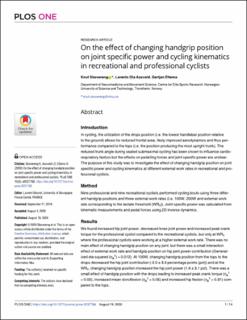| dc.contributor.author | Skovereng, Knut | |
| dc.contributor.author | Aasvold, Lorents Ola | |
| dc.contributor.author | Ettema, Gertjan | |
| dc.date.accessioned | 2020-09-14T07:39:01Z | |
| dc.date.available | 2020-09-14T07:39:01Z | |
| dc.date.created | 2020-08-24T08:45:37Z | |
| dc.date.issued | 2020 | |
| dc.identifier.issn | 1932-6203 | |
| dc.identifier.uri | https://hdl.handle.net/11250/2677534 | |
| dc.description.abstract | Introduction
In cycling, the utilization of the drops position (i.e. the lowest handlebar position relative to the ground) allows for reduced frontal area, likely improved aerodynamics and thus performance compared to the tops (i.e. the position producing the most upright trunk). The reduced trunk angle during seated submaximal cycling has been shown to influence cardiorespiratory factors but the effects on pedalling forces and joint specific power are unclear. The purpose of this study was to investigate the effect of changing handgrip position on joint specific power and cycling kinematics at different external work rates in recreational and professional cyclists.
Method
Nine professional and nine recreational cyclists performed cycling bouts using three different handgrip positions and three external work rates (i.e. 100W, 200W and external work rate corresponding to the lactate threshold (WRlt)). Joint specific power was calculated from kinematic measurements and pedal forces using 2D inverse dynamics.
Results
We found increased hip joint power, decreased knee joint power and increased peak crank torque for the professional cyclist compared to the recreational cyclists, but only at WRlt where the professional cyclists were working at a higher external work rate. There was no main effect of changing handgrip position on any joint, but there was a small interaction effect of external work rate and handgrip position on hip joint power contribution (Generalized eta squared (ηg2) = 0.012). At 100W, changing handgrip position from the tops to the drops decreased the hip joint contribution (-2.0 ± 3.9 percentage points (pct)) and at the WRlt, changing handgrip position increased the hip joint power (1.6 ± 3.1 pct). There was a small effect of handgrip position with the drops leading to increased peak crank torque (ηg2 = 0.02), increased mean dorsiflexion (ηg2 = 0.05) and increased hip flexion (ηg2 = 0.31) compared to the tops.
Discussion
The present study demonstrates that there is no main effect of changing handgrip position on joint power. Although there seems to be a small effect on hip joint power when comparing across large ranges in external work rate, any potential negative performance effect would be outweighed by the aerodynamic benefit of the drops position. | en_US |
| dc.language.iso | eng | en_US |
| dc.publisher | Public Library of Science | en_US |
| dc.rights | Navngivelse 4.0 Internasjonal | * |
| dc.rights.uri | http://creativecommons.org/licenses/by/4.0/deed.no | * |
| dc.title | On the effect of changing handgrip position on joint specific power and cycling kinematics in recreational and professional cyclists | en_US |
| dc.type | Peer reviewed | en_US |
| dc.type | Journal article | en_US |
| dc.description.version | publishedVersion | en_US |
| dc.source.journal | PLOS ONE | en_US |
| dc.identifier.doi | https://doi.org/10.1371/journal.pone.0237768 | |
| dc.identifier.cristin | 1824693 | |
| dc.description.localcode | Copyright: © 2020 Skovereng et al. This is an open access article distributed under the terms of the Creative Commons Attribution License, which permits unrestricted use, distribution, and reproduction in any medium, provided the original author and source are credited. | en_US |
| cristin.ispublished | true | |
| cristin.fulltext | original | |
| cristin.qualitycode | 1 | |

